What constitutes a ‘document’ and how does it function?
According to the Oxford English Dictionary, the etymological origin is the Latin ‘documentum’, meaning ‘lesson, proof, instance, specimen’. As a verb, it is ‘to prove or support (something) by documentary evidence’, and ‘to provide with documents’. The online version of the OED includes a draft addition, whereby a document (as a noun) is ‘a collection of data in digital form that is considered a single item and typically has a unique filename by which it can be stored, retrieved, or transmitted (as a file, a spreadsheet, or a graphic)’. The current use of the noun ‘document’ is defined as ‘something written, inscribed, etc., which furnishes evidence or information upon any subject, as a manuscript, title-deed, tomb-stone, coin, picture, etc.’ (emphasis added).
Both ‘something’ and that first ‘etc.’ leave ample room for discussion. A document doubts whether it functions as something unique, or as something reproducible. A passport is a document, but a flyer equally so. Moreover, there is a circular reasoning: to document is ‘to provide with documents’. Defining (the functioning of) a document most likely involves ideas of communication, information, evidence, inscriptions, and implies notions of objectivity and neutrality – but the document is neither reducible to one of them, nor is it equal to their sum. It is hard to pinpoint it, as it disperses into and is affected by other fields: it is intrinsically tied to the history of media and to important currents in literature, photography and art; it is linked to epistemic and power structures. However ubiquitous it is, as an often tangible thing in our environment, and as a concept, a document deranges.
the-documents.org continuously gathers documents and provides them with a short textual description, explanation,
or digression, written by multiple authors. In Paper Knowledge, Lisa Gitelman paraphrases ‘documentalist’ Suzanne Briet, stating that ‘an antelope running wild would not be a document, but an antelope taken into a zoo would be one, presumably because it would then be framed – or reframed – as an example, specimen, or instance’. The gathered files are all documents – if they weren’t before publication, they now are. That is what the-documents.org, irreversibly, does. It is a zoo turning an antelope into an ‘antelope’.
As you made your way through the collection,
the-documents.org tracked the entries you viewed.
It documented your path through the website.
As such, the time spent on the-documents.org turned
into this – a new document.
This document was compiled by ____ on 08.02.2022 18:51, printed on ____ and contains 16 documents on _ pages.
(https://the-documents.org/log/08-02-2022-3782/)
the-documents.org is a project created and edited by De Cleene De Cleene; design & development by atelier Haegeman Temmerman.
the-documents.org has been online since 23.05.2021.
- De Cleene De Cleene is Michiel De Cleene and Arnout De Cleene. Together they form a research group that focusses on novel ways of approaching the everyday, by artistic means and from a cultural and critical perspective.
www.decleenedecleene.be / info@decleenedecleene.be - This project was made possible with the support of the Flemish Government and KASK & Conservatorium, the school of arts of HOGENT and Howest. It is part of the research project Documenting Objects, financed by the HOGENT Arts Research Fund.
- Briet, S. Qu’est-ce que la documentation? Paris: Edit, 1951.
- Gitelman, L. Paper Knowledge. Toward a Media History of Documents.
Durham/ London: Duke University Press, 2014. - Oxford English Dictionary Online. Accessed on 13.05.2021.

At a dental practice, the white Alligat®-powder is mixed with the right amount of water to get a mouldable dough that is pressed upon a patient’s teeth. After thirty seconds, the Alligat®-dough stiffens and takes on a rubber-like quality. At that point, still white, it must be removed from the patient’s mouth. Over the next few hours, the mould turns increasingly pink as the substance becomes less humid. Now, it can be used as a mould to create a positive master cast of the patient’s teeth.
Outside the dental practice, the powder’s possibilities remain to be fully explored.

First published as part of De Cleene De Cleene. ‘Amidst the Fire, I Was Not Burnt’, Trigger (Special issue: Uncertainty), 2. FOMU/Fw:Books, 25-30

All chairs are empty, but all face something different. The bottom photograph shows empty chairs facing empty desks. In the middle picture, empty chairs face each other (underneath the inaudible sound of the cinema above). In the top photograph, the chairs seem to be facing the photographer. However, the altar’s in front of the photographer. He stands at the back of the provisional church. The chairs face the photographer and have turned their backs to the altar.
Revue Héraclite, 5 (1), april 1936, p. 7, paper, from the archive of architect O. Clemminck.
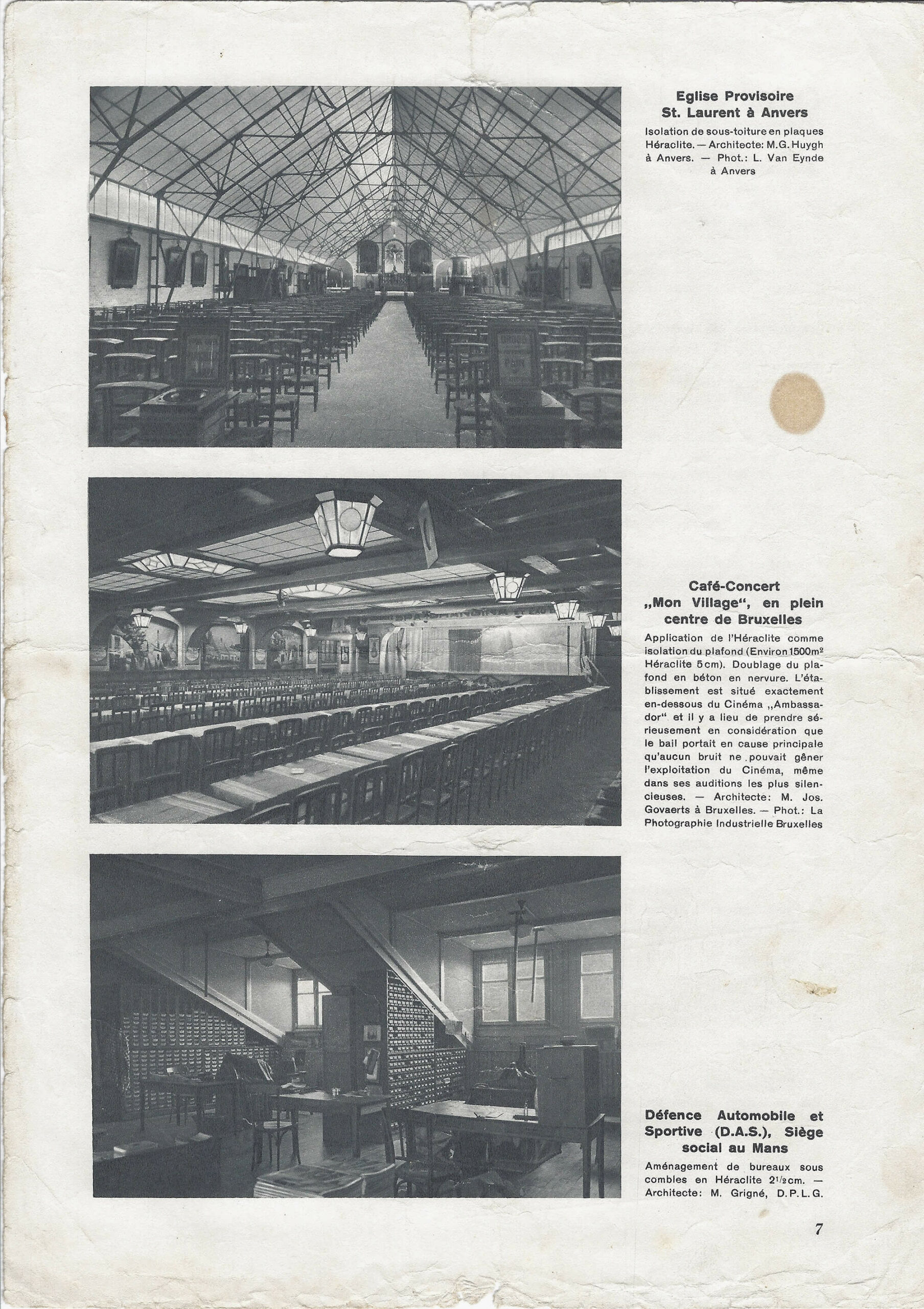
The Bahrain Formula 1 Grand Prix takes place every year since the track’s inauguration in 2004 – except for 2011 when the race was cancelled due to protests in the wake of the Arab Spring. To prevent sand from covering the track and entering the air-ducts and engines, the sand near the track is sprayed with an adhesive to keep it from blowing around.
The cloud of sand in the picture (made near Avenue 61 on an artificial island close to Seef) was made by kicking it into the frame while M.R. and M.D.C. had to stop and wait for a truck that was being towed after the driver lost control over the vehicle and flipped it onto its side. Days earlier M.D.C. had tried to make a photograph of the F1-track, but couldn’t get close enough to make a decent picture.
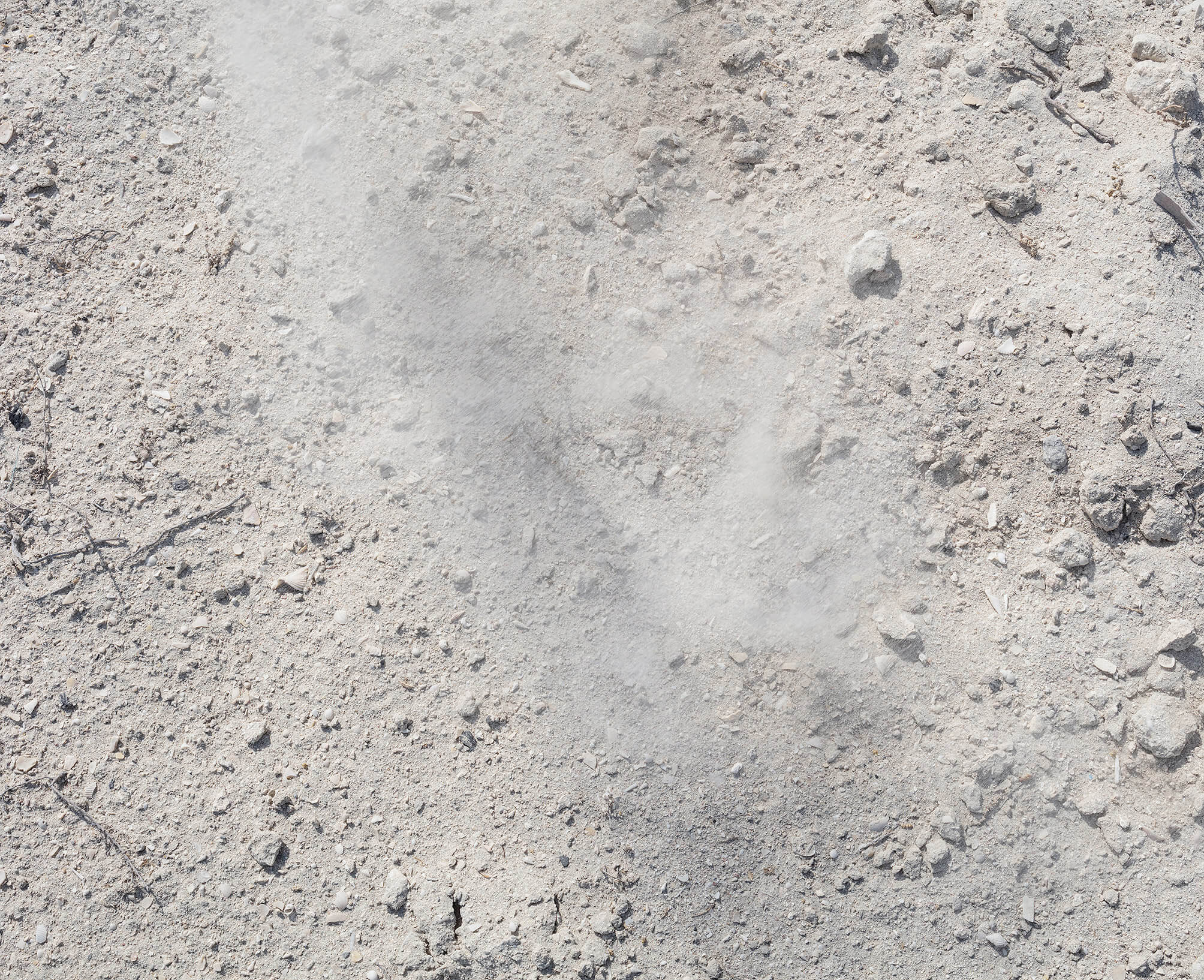
Ten years ago, in November, I drove up to Frisia – the northernmost province of The Netherlands. I was there to document the remains of air watchtowers: a network of 276 towers that were built in the fifties and sixties to warn the troops and population of possible aerial danger coming from the Soviet Union. It was very windy. The camera shook heavily. The poplars surrounding the concrete tower leaned heavily to one side.
I drove up to the seaside, a few kilometers farther. The wind was still strong when I reached the grassy dike that overlooked the kite-filled beach. I exposed the last piece of film left on the roll. Strong gusts of wind blew landwards.
Months later I didn’t bother to blow off the dust that had settled on the film before scanning it. A photograph without use, with low resolution, made for the sake of the archive’s completeness.
The dust on the film appears to be carried landwards, by the same gust of wind lifting the kites.
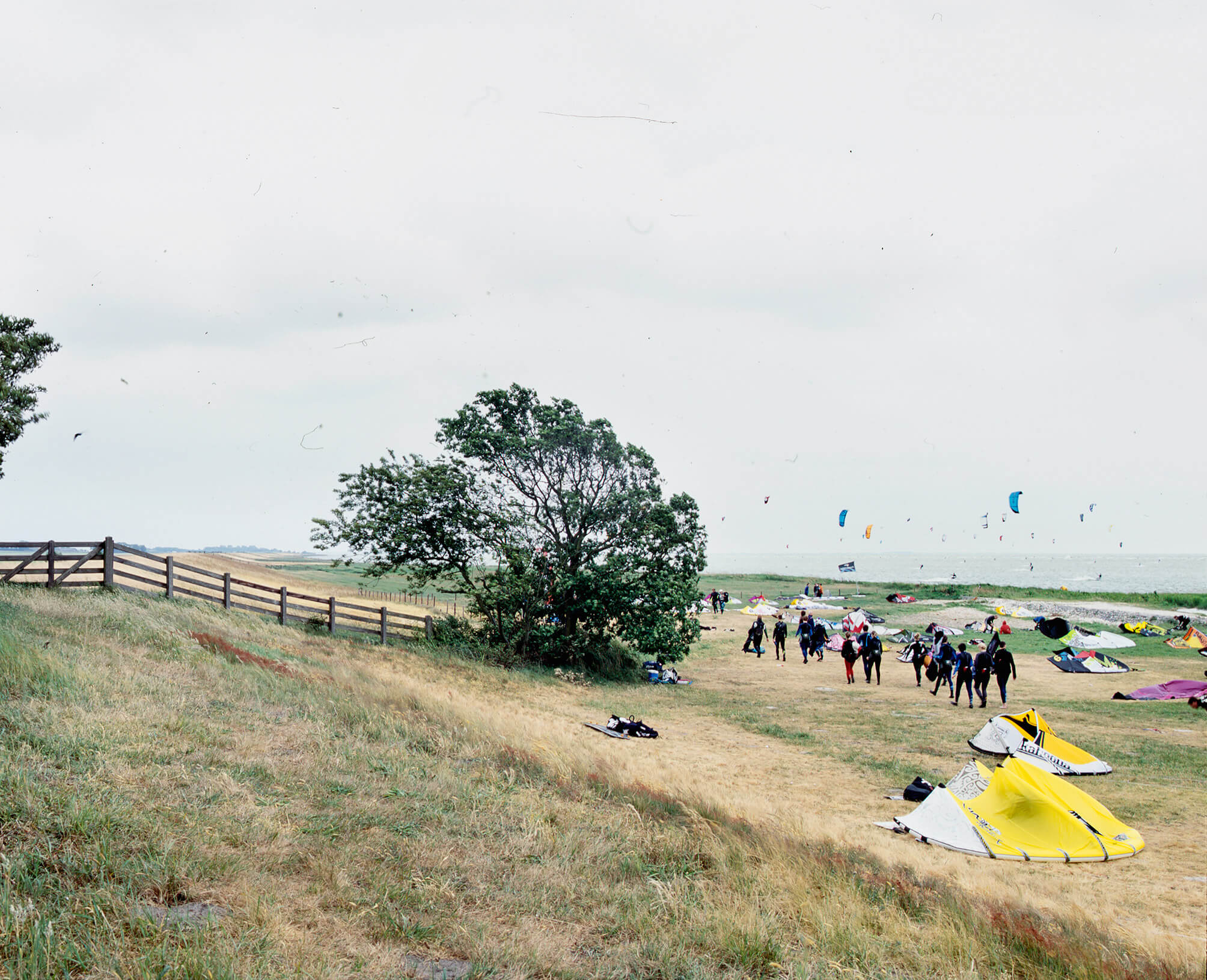
At the State Archive in Kortrijk, I am leafing through a 1955 photo album of the construction of the provisional church in Lokeren by the famous furniture company Kunstwerkstede De Coene. Gigantic wooden, prefabricated beams structure the building. It is cold. An old man in a grey suit shuffles between the racks to look up the date of birth of his great great grandmother. Snow covers the unfinished provisional roof. A bus passes, I reckon, through the pouring rain.
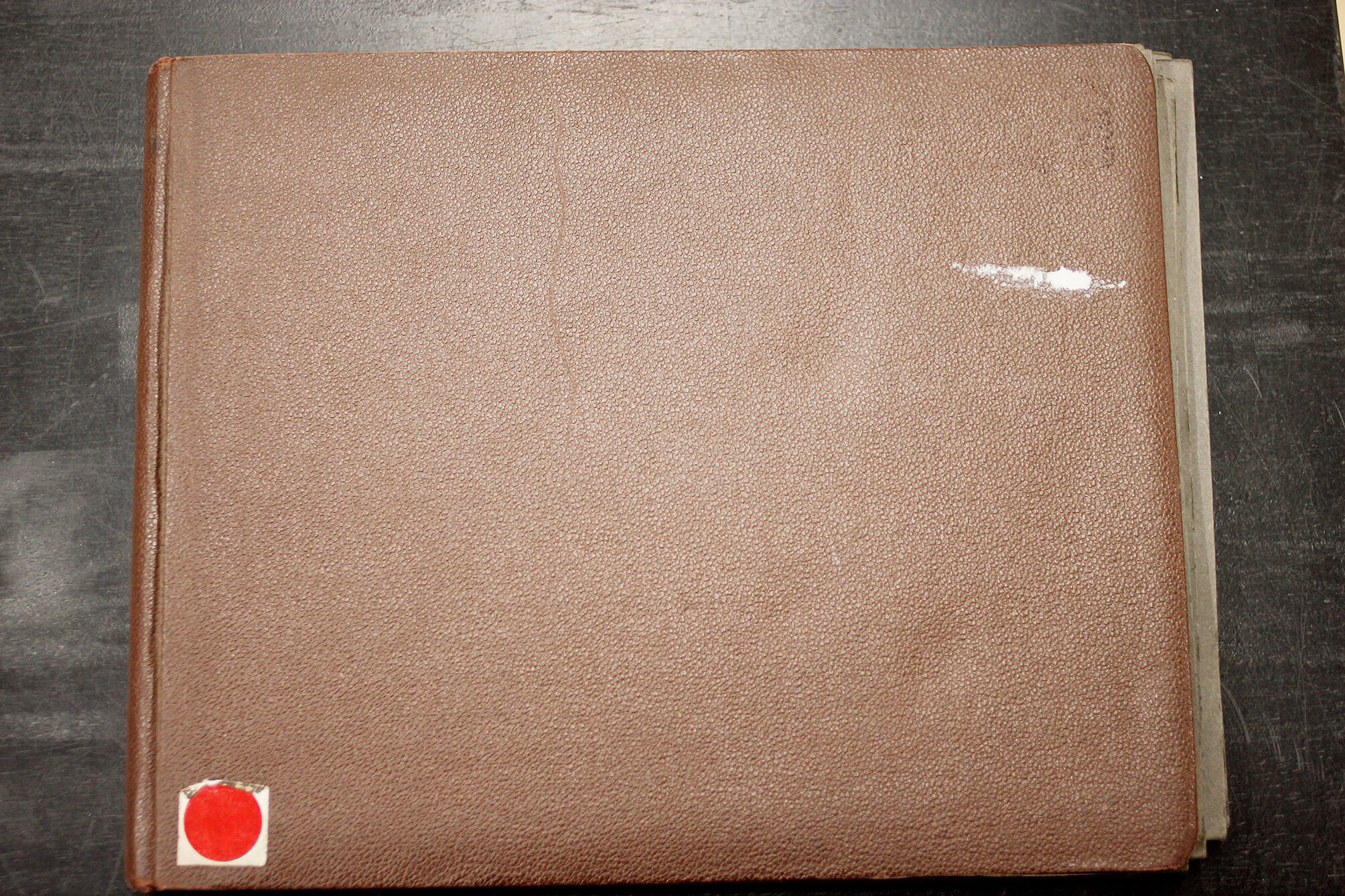
In Boarhunt, close to Winchester (UK), the fort houses the Royal Armouries’ artillery collection. It contains parts of the ‘Project Babylon’ space gun, the two part bronze Dardanelles Gun and a collection of French field guns, captured in Waterloo. On the lawn to the South of the fort two neat piles of fifteen1 36” shells flank a Mallet’s Mortar. Manufactured in 1857, the mortar remains unfired up to this day.2 In 1873, its inventor – the engineer and geophysicist Robert Mallet – publishes his translation of Luigi Palmieri’s Incendio Vesuviano. Before giving a lengthy account of his take on the present state of vulcanicity, he briefly introduces the famous Italian vulcanologist’s report: ‘The following Memoir of Signor Palmieri on the eruption of Vesuvius in April of this year (1872), brief as it is, embraces two distinct subjects, viz., his narrative as an eye-witness of the actual events of the eruption as they occurred upon the cone and slopes of the mountain, and his observations as to pulses emanating from its interior, as indicated by his Seismograph, and as to the electric conditions of the overhanging cloud of smoke (so called) and ashes, as indicated by his bifilar electrometer, both established at the Observatory.’
O
O OOO
OOO OOOOOOO
In the outskirts of East of London, along Repository road in Woolwich, the only other mortar of this type is installed. This particular one fired nineteen shells on three occasions. Each time resulting in a damaged mortar.
Screenshot taken from AbeBooks, where the first edition of The Eruption of Vesuvius in 1872 with Notes, and an Introductory Sketch on the Present State of Knowledge of Terrestrial Vulcanicity, the Cosmical Nature and Relations of Volcanoes and Earthquakes is listed for 1895,00 USD. https://www.abebooks.com/first-edition/Eruption-Vesuvius-1872.with-Notes-Introductory-Sketch/439314424/bd
Project Gutenberg’s The Eruption of Vesuvius in 1872, by Luigi Palmieri (translated by Mallet) can be found at: https://www.gutenberg.org/files/33483/33483-h/33483-h.htm
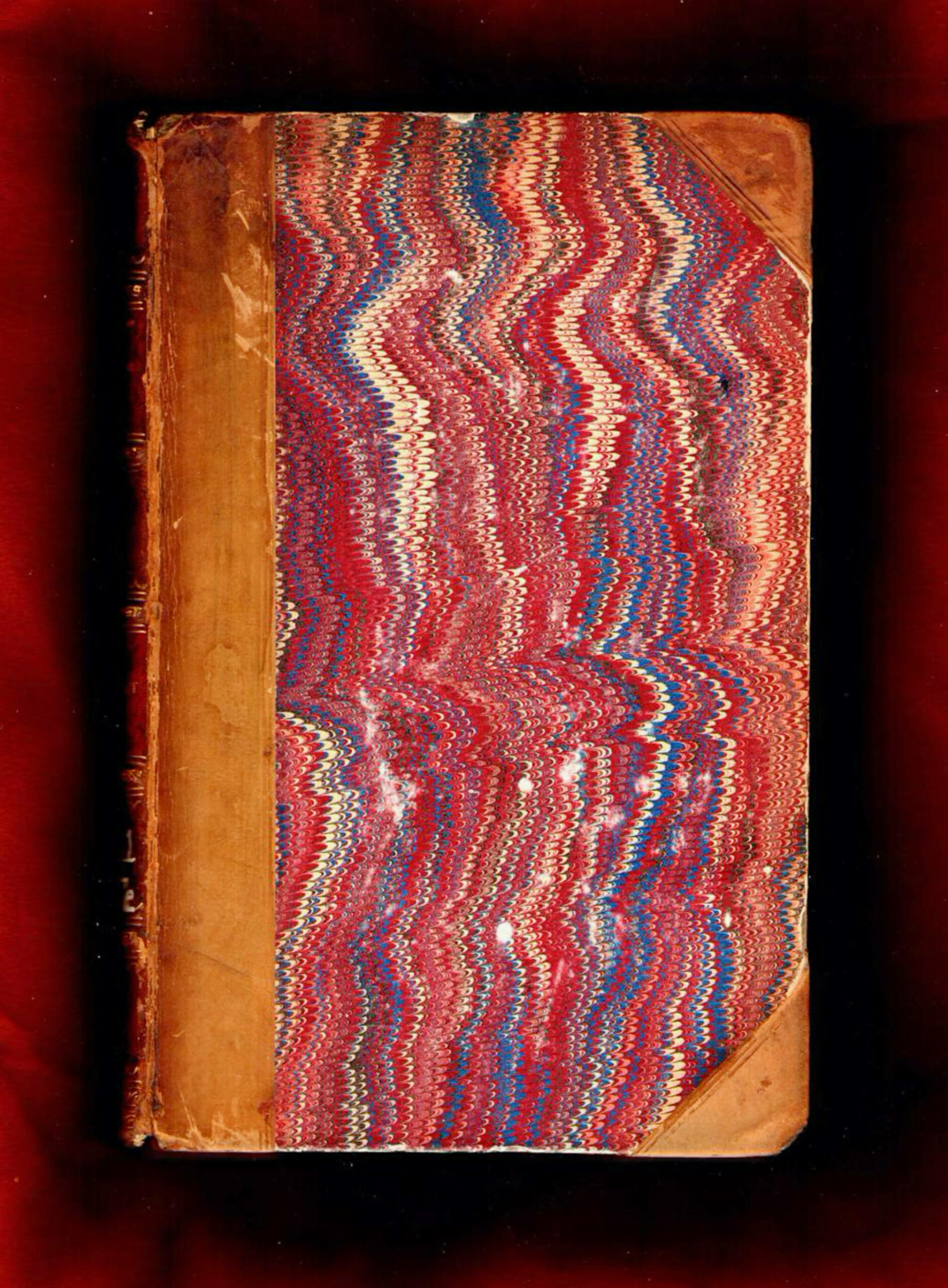
A block of concrete. Fissures are showing and rebar is sticking out from all sides. If it were still straight, the block would measure approximately 130 x 15 x 40cm.
It is lying by the side of the road, a few hundred meters from a construction site. It appears to be shaped by impact. Maybe the block plummeted to the ground from a great height. Perhaps, something heavy hit it. For all one knows, it served as a column and was exposed to an unforeseen amount of pressure, causing it to buckle.
According to Eyal Weizman ‘[a]rchitecture emerges as a documentary form, not because photographs of it circulate in the public domain but rather because it performs variations on the following three things: it registers the effect of force fields, it contains or stores these forces in material deformations, and, with the help of other mediating technologies and the forum, it transmits this information further.’1
Weizman, E. ‘Introduction’, in: Forensic Architecture. Forensis. The Architecture of Public Truth. London/Berlin: Sternberg Press, 2014.
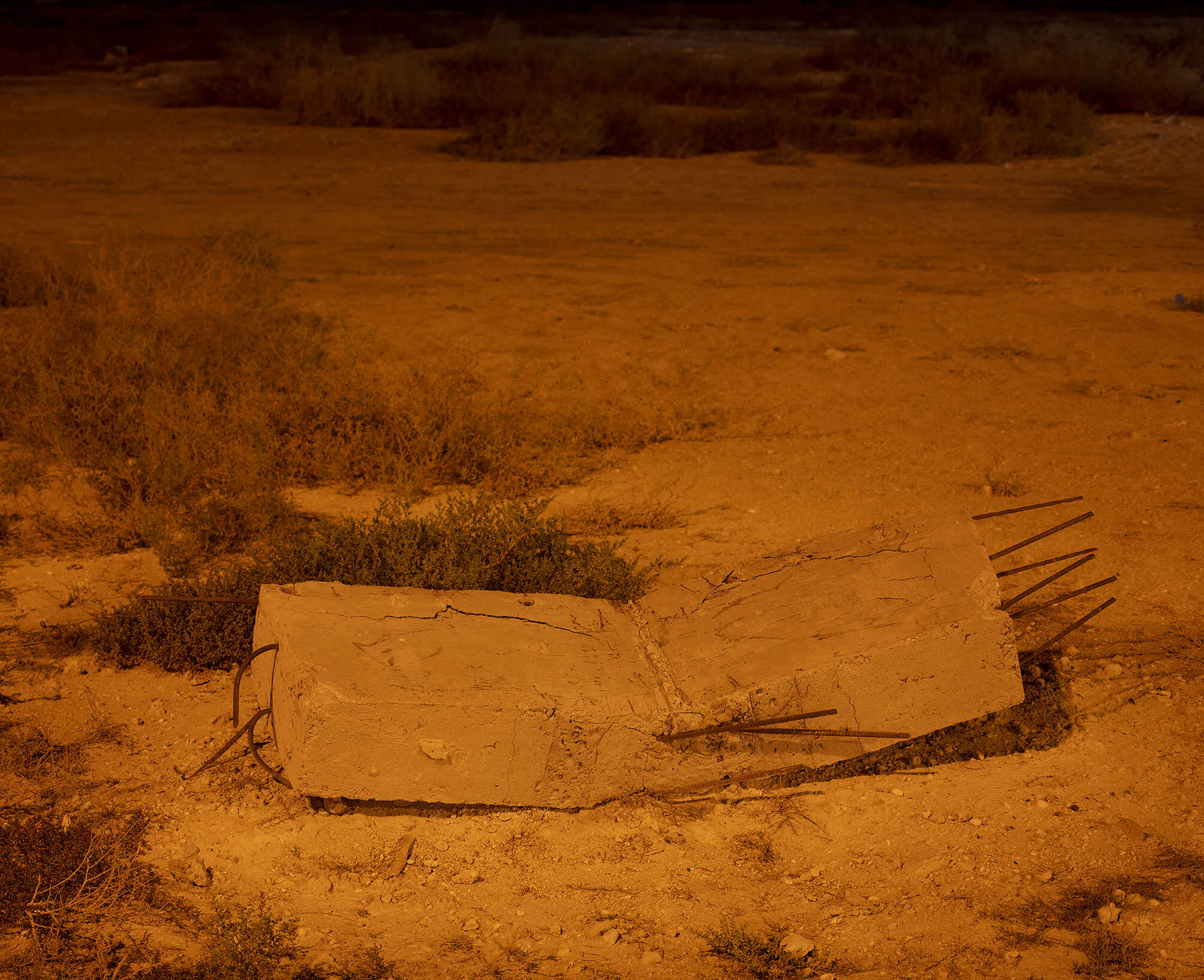
I must have driven past this rocky landscape about sixteen times, going back and forth between viewpoints and the house the parents of a friend let me stay in. On the last day, I left early for the airport, pulled into a lay-by, took my tripod and camera out of the trunk of the red Volkswagen Polo rental car and made two photographs.1 It was only when I got home, had the film developed, scanned it and was removing dust particles from the file, that I discovered the hand painted text on the rock: ‘PROIBIDO BUSCAR SETAS’.
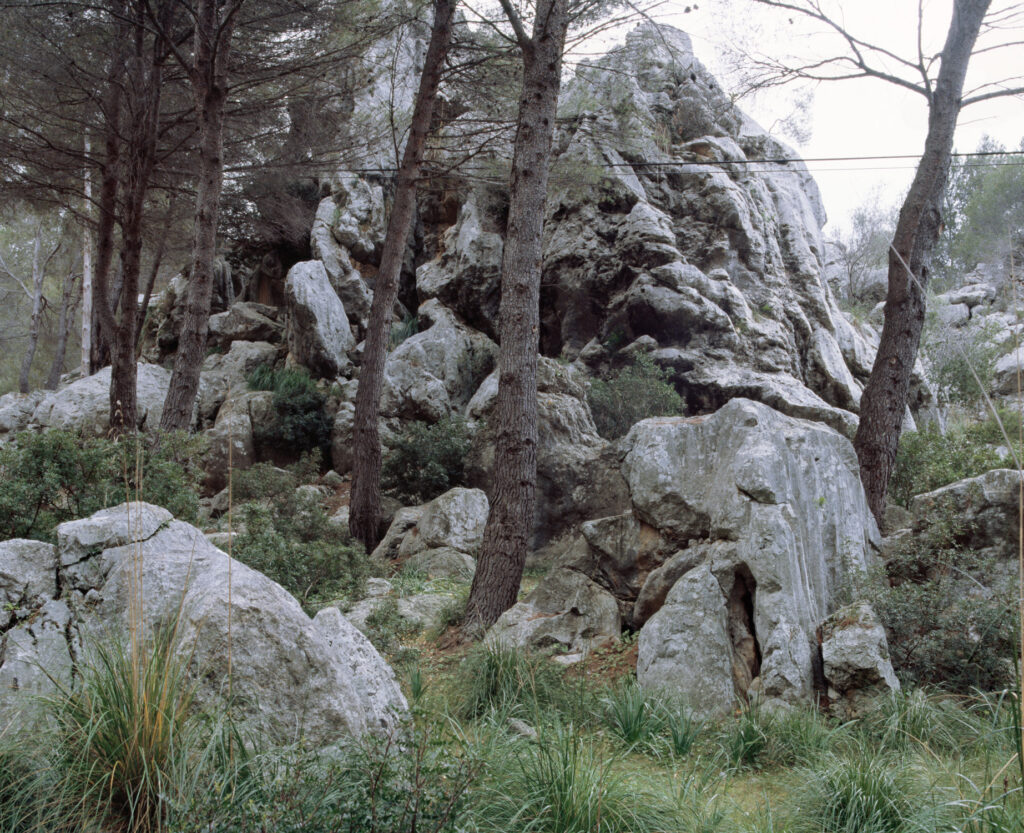
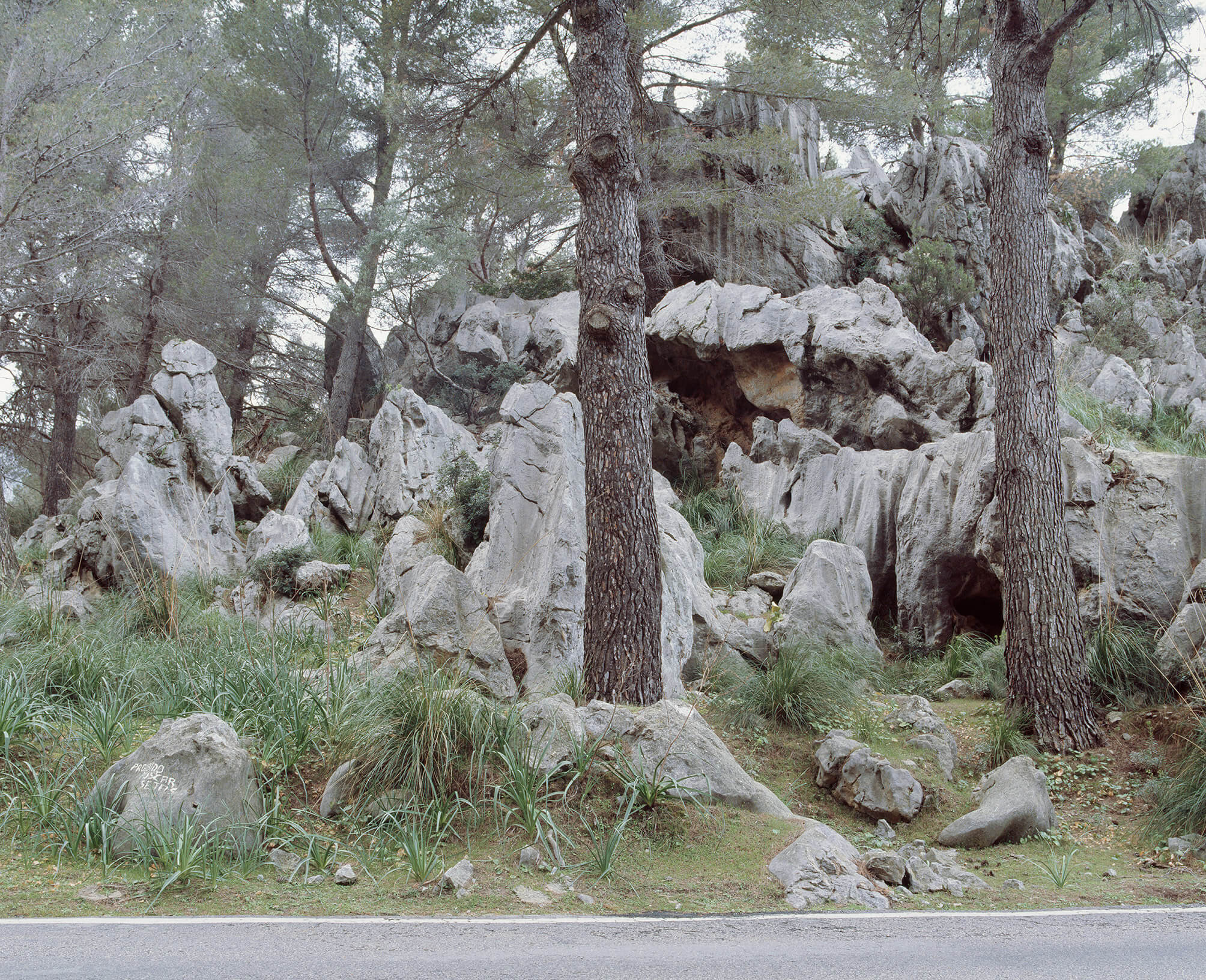
A visit to the Royal Observatory of Belgium, in Ukkel. Most of the domes are damaged and need repairing. Only a few telescopes are in use. It is difficult to find a good spot from which to film the site. When we asked the people at the Royal Meteorological Institute – the Observatory’s neighbouring institution – if we could access their building’s roof to film the observatory, the answer was ‘no’.
I (M.D.C.) remember there was a fire nearby. We couldn’t see the flames, but a tall dark plume of smoke rose above the trees lining the site. We didn’t insist any longer and ceased our attempt to access the roof, hoping we might find a good spot to film the smoke with a dome in the foreground.
Kesteloot, J. Leerboek van Cosmografie voor Middelbaar en Lager Normaal Onderwijs (derde vermeerderde uitgave). Brugge: Firma Karel Beyaert, 1948.

The 48-inch Oschin Schmidt, a renowned reflecting telescope at Palomar Observatory, California, was used for the Palomar Observatory Sky Survey (POSS), published in 1958, one of the largest photographic surveys of the night sky.
Based on the man’s pipe shadow’s direction, thrown onto the telescope, there is reason to believe an off-camera flash was used to make the picture.
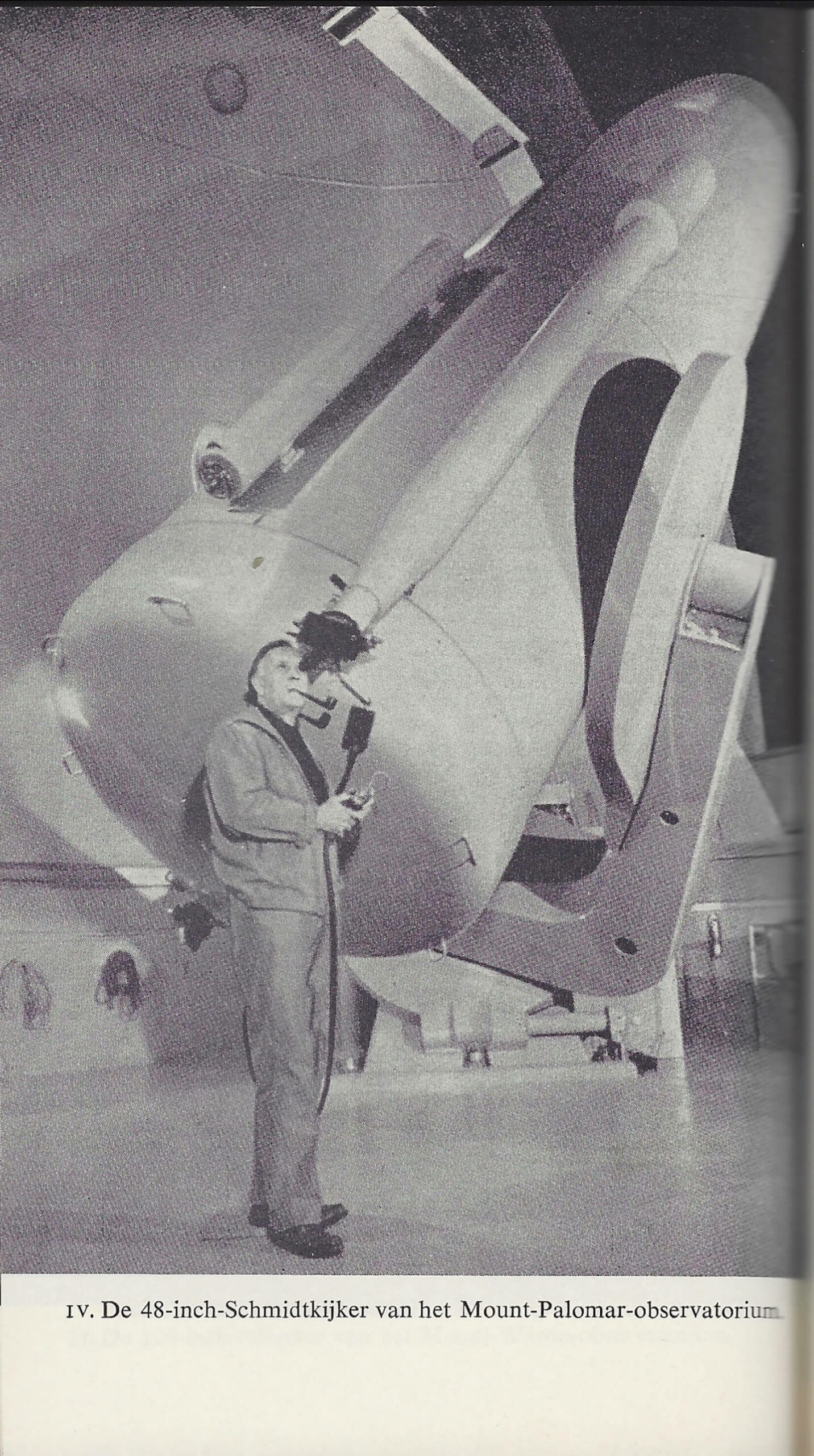
Every two weeks, The New York Review of Books falls into my letterbox. Those are good days. Most often, I won’t get to reading it, but what I instantly do, is check the last page with ‘The Classifieds’. The people writing the (genuine, not fictitious) adverts and inquiries reappear every so often. I happily assume the position of the implied reader, as they address the presumed readers of the review. There’s a ‘charismatic, aging French rock star’ providing original songs in Franglais. There are top notch apartments in Paris for aspiring writers. There are those seeking love and astronomical peculiarities: ‘Hitch my wagon to a star – Looking for a bright sophisticated senior star gazer! CStein3981@aol.com’.
The New York Review of Books, March 11, 2021, Volume LXVIII, Number 4.

On March 23th 2015, a high pressure system above Panama Bay blew strong winds landwards. At the Gatun locks, one of the webcams overlooking the Canal neglected the traffic and briefly captured its own images. The ship’s presumed passage through the Gatun locks wasn’t recorded by this camera and the AIS-transponder did not save any data of the ship’s transit from the Pacific to the Atlantic side of the canal: the Authenticity managed to swap oceans undetected.
On February 16th 2016, the transponder still signals the ship near the port of Bahia Las Minas. The current is calm, the ship has been practically immobile for a year.
First published in: De Cleene, M. Reference Guide. Amsterdam: Roma Publications, 2019
Webcam Gatun Locks, Panama Canal, http://www.pancanal.com
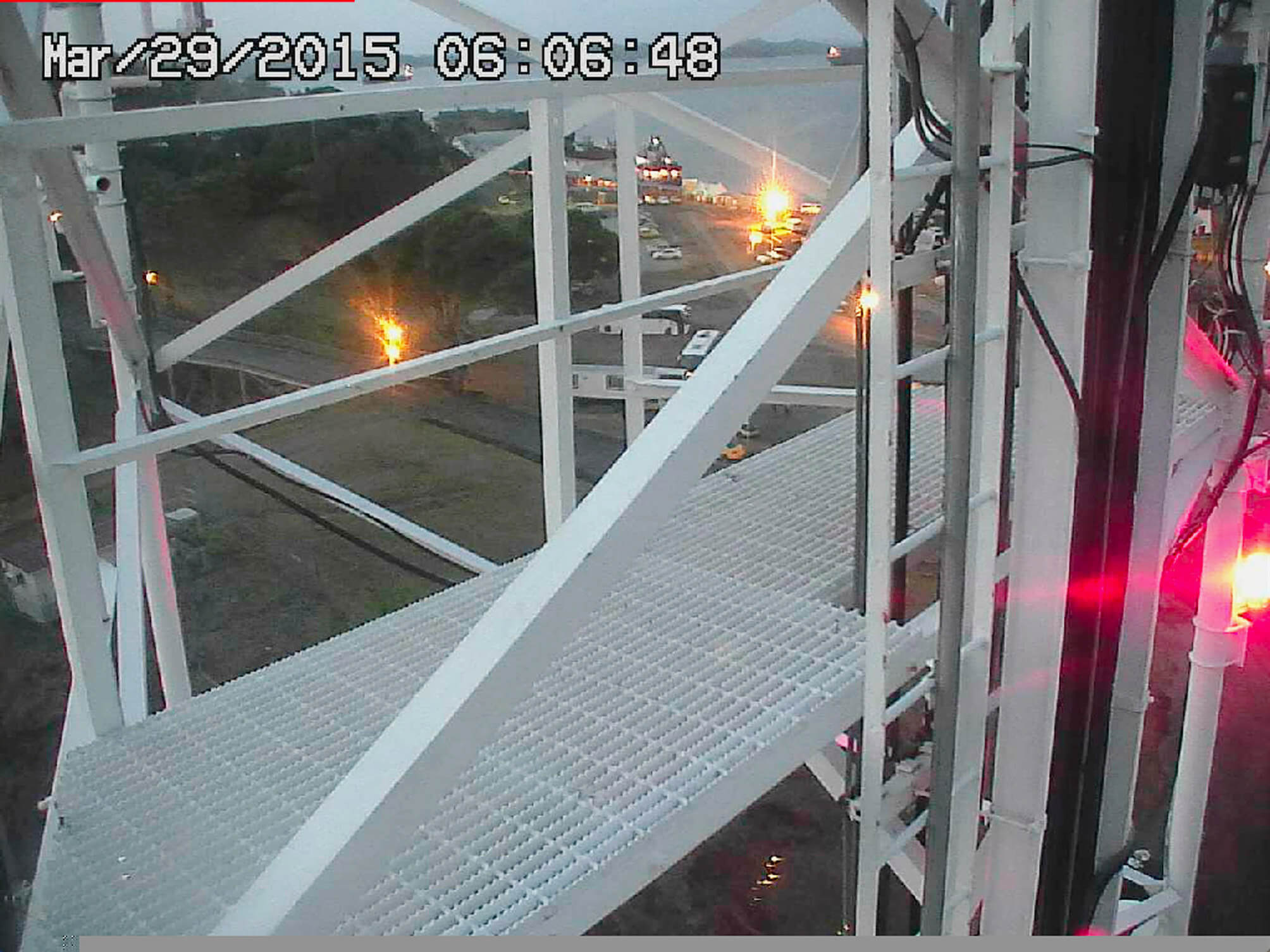
In Boarhunt, close to Winchester (UK), the fort houses the Royal Armouries’ artillery collection. It contains parts of the ‘Project Babylon’ space gun, the two part bronze Dardanelles Gun and a collection of French field guns, captured in Waterloo. On the lawn to the South of the fort two neat piles of fifteen1 36” shells flank a Mallet’s Mortar. Manufactured in 1857, the mortar remains unfired up to this day.2 In 1873, its inventor – the engineer and geophysicist Robert Mallet – publishes his translation of Luigi Palmieri’s Incendio Vesuviano. Before giving a lengthy account of his take on the present state of vulcanicity, he briefly introduces the famous Italian vulcanologist’s report: ‘The following Memoir of Signor Palmieri on the eruption of Vesuvius in April of this year (1872), brief as it is, embraces two distinct subjects, viz., his narrative as an eye-witness of the actual events of the eruption as they occurred upon the cone and slopes of the mountain, and his observations as to pulses emanating from its interior, as indicated by his Seismograph, and as to the electric conditions of the overhanging cloud of smoke (so called) and ashes, as indicated by his bifilar electrometer, both established at the Observatory.’
O
O OOO
OOO OOOOOOO
In the outskirts of East of London, along Repository road in Woolwich, the only other mortar of this type is installed. This particular one fired nineteen shells on three occasions. Each time resulting in a damaged mortar.
Screenshot taken from AbeBooks, where the first edition of The Eruption of Vesuvius in 1872 with Notes, and an Introductory Sketch on the Present State of Knowledge of Terrestrial Vulcanicity, the Cosmical Nature and Relations of Volcanoes and Earthquakes is listed for 1895,00 USD. https://www.abebooks.com/first-edition/Eruption-Vesuvius-1872.with-Notes-Introductory-Sketch/439314424/bd
Project Gutenberg’s The Eruption of Vesuvius in 1872, by Luigi Palmieri (translated by Mallet) can be found at: https://www.gutenberg.org/files/33483/33483-h/33483-h.htm

It’s 21:49 on Tuesday May 4th 2021. I’m sifting through the folders of a back-up drive. When I reach Archief2A/2017/wigny donder, the subfolder contains 103 items (97 DNG-files, 1 JPEG-file and 5 PSD-files). The photographs are all very similar. They show the silhouette of the same tree and hills, the red light of the telecommunications mast on the left and the orange glow of the street’s sodium lights. The thunderstorm moves from right to left. _44A3920 is the only exposure (10 seconds) that recorded lightning bolts.
I looked up heat lightning, also known as silent lightning, summer lightning, or dry lightning, which is simply cloud-to-ground lightning that occurs very far away, with thunder that dissipates before it reaches the observer. On YouTube I watched: Top 10 Dangerous Lightning Strikes Thunder recorded on Camera (HIGH VOLTAGE!!) followed by Lightning Strikes at the 2019 U.S. Women’s Open. It’s 22:07, I am doubtful at first but become convinced I can hear thunder afar.

Robert Nemiroff and Jerry Bonnell’s lesser known project (R.N. and J.B. being the creators of Astronomy Picture of The Day), was making websites containing over a million of digits of square roots of irrational numbers, e.g. seven. ‘They were computed during spare time on a VAX alpha class machine over the course of a weekend. […] We believe these are the most digits ever computed for the square root of seven on or before 1 April 1994.’ Elsewhere, R.N. states: ‘They are not copyrighted and we do not think it is legally justifiable to copyright such a basic thing as the digits of a commonly used irrational number.’ If one wanted to get a copy of the 10 million digits of the square root of the number e R.N. and J.B. computed in their spare time, one can send an email to R.N. at nemiroff@grossc.gsfc.nasa.gov.
https://apod.nasa.gov/htmltest/gifcity/sqrt7.1mil
https://apod.nasa.gov/htmltest/rjn_dig.html
https://apod.nasa.gov/htmltest/rjn.html

In summer, the roofing gets hot and soft. In winter, it gets cold, hard and brittle. None of the gates to the garages are open. It’s unsure whether the numerous texts and drawings – some dig deeper than others – have caused leakages.
